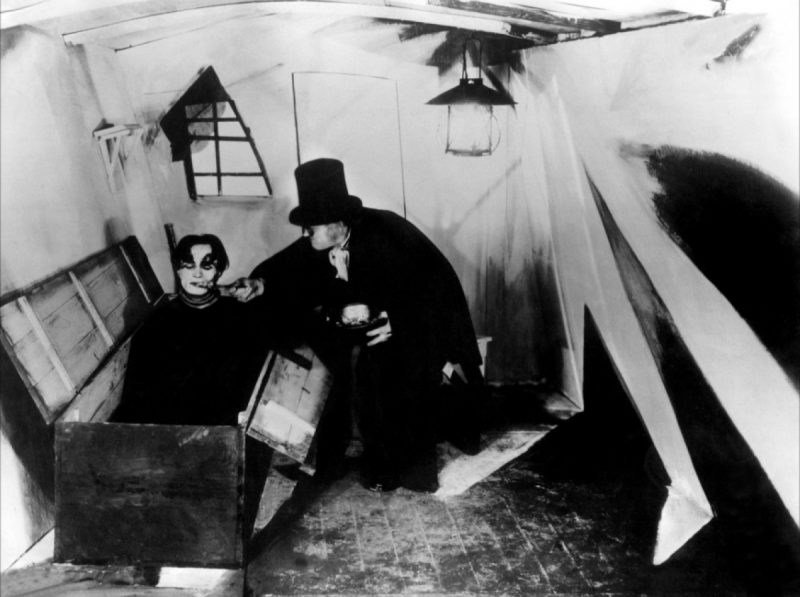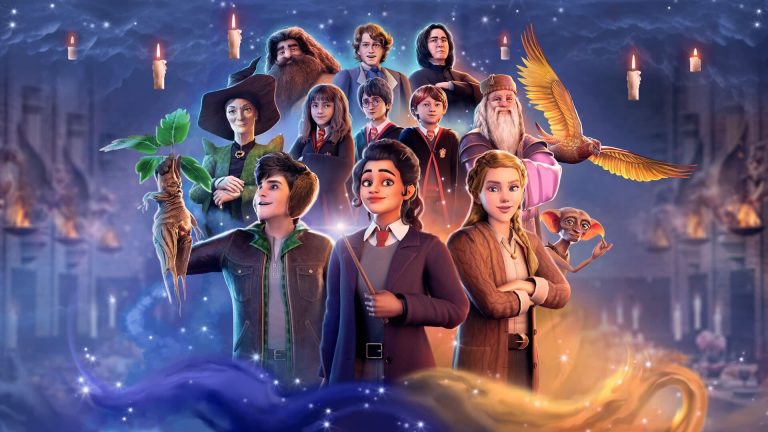In 1913, Germany, flush with a new nation’s patriotic zeal, looked like it might become the dominant nation of Europe and a real rival to that global superpower Great Britain. Then it hit the buzzsaw of World War I. After the German government collapsed in 1918 from the economic and emotional toll of a half-decade of senseless carnage, the Allies forced it to accept draconian terms for surrender. The entire German culture was sent reeling, searching for answers to what happened and why.
German Expressionism came about to articulate these lacerating questions roiling in the nation’s collective unconscious. The first such film was The Cabinet of Dr. Caligari (1920), about a malevolent traveling magician who has his servant do his murderous bidding in the dark of the night. The storyline is all about the Freudian terror of hidden subconscious drives, but what really makes the movie memorable is its completely unhinged look. Marked by stylized acting, deep shadows painted onto the walls, and sets filled with twisted architectural impossibilities — there might not be a single right angle in the film – Caligari’s look perfectly meshes with the narrator’s demented state of mind.
Subsequent German Expressionist movies retreated from the extreme aesthetics of Caligari but were still filled with a mood of violence, frustration and unease. F. W. Murnau’s brilliantly depressing The Last Laugh (1924) is about a proud doorman at a high-end hotel who is unceremoniously stripped of his position and demoted to a lowly bathroom attendant. When he hands over his uniform, his posture collapses as if the jacket were his exoskeleton. You don’t need to be a semiotician to figure out that the doorman’s loss of status parallels Germany’s. Fritz Lang’s M (1931), a landmark of early sound film, is the first serial killer movie ever made. But what starts out as a police procedural turns into something even more unsettling when a gang of distinctly Nazi-like criminals decide to mete out some justice of their own.
German Expressionism ended in 1933 when the Nazis came to power. They weren’t interested in asking uncomfortable questions and viewed such dark tales of cinematic angst as unpatriotic. Instead, they preferred bright, cheerful tales of Aryan youths climbing mountains. By that time, the movement’s most talented directors — Fritz Lang and F.W. Murnau — had fled to America. And it was in America where German Expressionism found its biggest impact. Its stark lighting, grotesque shadows and bleak worldview would go on to profoundly influence film noir in the late 1940s after another horrific, disillusioning war. See our collection of Free Noir Films here.
You can watch 10 German Expressionist movies – including Caligari, Last Laugh and M — for free below.
- Nosferatu — Free — German Expressionist horror film directed by F. W. Murnau. An unauthorized adaptation of Bram Stoker’s Dracula. (1922)
- The Student of Prague — Free — A classic of German expressionist film. German writer Hanns Heinz Ewers and Danish director Stellan Rye bring to life a 19th-century horror story. Some call it the first indie film. (1913)
- Nerves — Free — Directed by Robert Reinert, Nerves tells of “the political disputes of an ultraconservative factory owner Herr Roloff and Teacher John, who feels a compulsive but secret love for Roloff’s sister, a left-wing radical.” (1919)
- The Cabinet of Dr. Caligari — Free — This silent film directed by Robert Wiene is considered one of the most influential German Expressionist films and perhaps one of the greatest horror movies of all time. (1920)
- Metropolis — Free — Fritz Lang’s fable of good and evil fighting it out in a futuristic urban dystopia. An important classic. (1927)
- The Golem: How He Came Into the World — Free — A follow-up to Paul Wegener’s earlier film, “The Golem,” about a monstrous creature brought to life by a learned rabbi to protect the Jews from persecution in medieval Prague. Based on the classic folk tale, and co-directed by Carl Boese. (1920)
- The Golem: How He Came Into the World — Free — The same film as the one listed immediately above, but this one has a score created by Pixies frontman Black Francis. (2008)
- The Last Laugh – Free — F.W. Murnau’s classic chamber drama about a hotel doorman who falls on hard times. A masterpiece of the silent era, the story is told almost entirely in pictures. (1924)
- Faust — Free – German expressionist filmmaker F.W. Murnau directs a film version of Goethe’s classic tale. This was Murnau’s last German movie. (1926)
- Sunrise: A Song of Two Humans — Free — Made by the German expressionist director F.W. Murnau. Voted in 2012, the 5th greatest film of all time. (1927)
- M — Free — Classic film directed by Fritz Lang, with Peter Lorre. About the search for a child murderer in Berlin. (1931)
For more classic films, peruse our larger collection, 4,000+ Free Movies Online: Great Classics, Indies, Noir, Westerns, Documentaries & More.
Note: An earlier version of this post appeared on our site in December, 2014.
If you would like to sign up for Open Culture’s free email newsletter, please find it here. It’s a great way to see our new posts, all bundled in one email, each day.
If you would like to support the mission of Open Culture, consider making a donation to our site. It’s hard to rely 100% on ads, and your contributions will help us continue providing the best free cultural and educational materials to learners everywhere. You can contribute through PayPal, Patreon, and Venmo (@openculture). Thanks!
Related Content:
How German Expressionism Influenced Tim Burton: A Video Essay
When the Nazis Declared War on Expressionist Art (1937)
Jonathan Crow is a writer and filmmaker whose work has appeared in Yahoo!, The Hollywood Reporter, and other publications.







